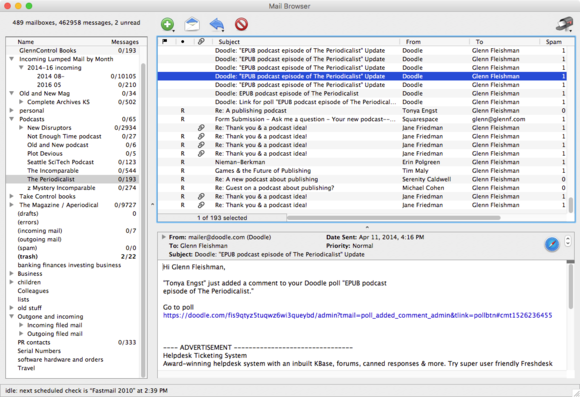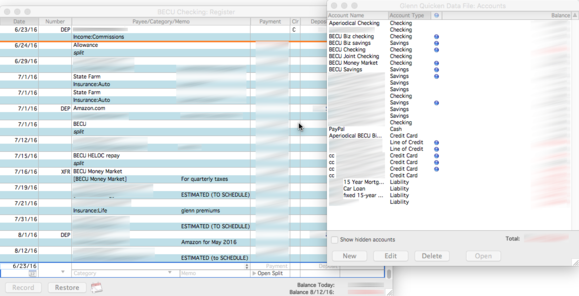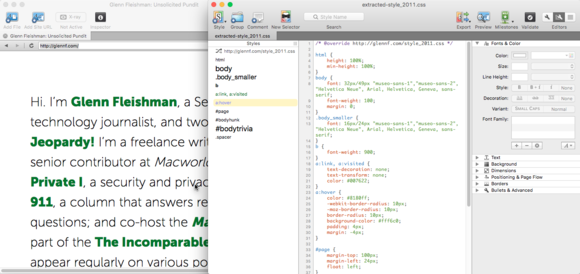Plenty of older software is good enough, smart enough, and gosh darn it, still works. A writer keeps his old tools sharp.
In some ways, you wouldn't suspect me of being out of date. I've got an iPhone 6s, a one-port MacBook, and an iPad Pro, and I spend my days typing at a walking desk—a standing desk with a treadmill underneath. (No man bun, though. Sorry.)
Scratch the surface, and I'm a man out of time. My email program doesn't display HTML and doesn't support IMAP. My personal finance program has "2007" in its name. When I need to muck about with CSS for a Web page, I fire up software left behind years ago by its developer. And my favorite new iOS app is the one-bit photography program BitCam.
It's not that I'm into artisanally handcrafted 1s and 0s, though—it's that nothing has appeared that provides the specific functionality I want, much less paired with improvements. I'm not alone. When I consult other long-time Mac users, I get a list of software to which they cling, some of which continues to receive compatibility updates, but is otherwise frozen with features from several years to a decade ago.
I have three programs I use extensively, one of them constantly, that are frozen in time: one for email, one for finances, and one for Web-page style editing.
That's not rich text, Rich
A number of years ago, I was on a large ship full of Mac enthusiasts as part of the first Mac Mania cruise. Rich Siegel, head of Bare Bones software, heard of my frustration related to email clients and introduced me to Mailsmith made by his firm. I wanted to escape Eudora, which I'd used for many years and which was still under active development, but had become creaky and out of date. Mailsmith had a lot in common with Eudora, but was even simpler.

Mailsmith shows only the text of emails. Click the Safari icon, and the HTML attachment opens in a browser.
It's text only—it doesn't display rich text or the HTML formatting of a message. It doesn't support threading messages. It only handles POP for retrieving messages, not IMAP. Its built-in search engine, while powerful, uses its own, slow index format instead of leaning on Spotlight. (Messages can be searched via Spotlight, but not previewed.)
And I couldn't love it more.
I avoided HTML email for the longest time, because of a combination of poorly-formatted messages and tracking codes (single-pixel GIFs and other images) used to determine whether a message had been opened or not. HTML messages can also be a vector on some platforms for malware—by avoiding rendering and using a relatively obscure client, I felt I avoided being a target. (Mail software eventually got smarter about options for auto-loading images and previewing attachments, too.)
Most email software and mailing-list software sends a separately encoded text attachment that's either derived from the HTML text or can be customized. Can I tell you the number of times I've received a strange old text message that's apparently the not-updated portion of an HTML marketing email template? Many times.
Mailsmith over the years added better and better ways to open the HTML attachment in a browser. While that does display tracking images and has other risks, I view very few of the messages I receive as HTML. I like the simplicity and legibility of reading only text in a size and font I choose.
Over the years, I've tried a couple dozen mail clients, including several versions of Apple's Mail, and none of them gave me everything I wanted, including compactness of mailbox display and filtering options. Even the slow internal search engine can't be beat, because it has as lot of choice compared to Spotlight: You can restrict against which mailboxes you search, and, using an advanced query, concatenate a set of rules to match, which can include regular expression pattern matching.
Bare Bones deprecated Mailsmith as a commercial product years ago. Siegel spun it off as a side project that he keeps updating for compatibility, not features.
Apple Mail has finally matured to a point in my installations where it doesn't crash, corrupt mailboxes, or lose messages, and I use it for secondary accounts. I'll be ready to jump ship if the time comes, or if I wind up having to switch to an IMAP-only mail host.
Even the company that makes it admits it
I'm not alone in keeping the coals of Quicken 2007 for Mac alive; many of us huddle around its warmth. I used multiple iterations of Quicken from the early 2000s through the 2007-dated release, updating as often as new releases came out. Each release generally, but not always, improved on the previous one.
Then a long winter set in. Intuit, Quicken's maker, seemed incapable of managing all the versions of Quicken it was working on, and years passed with nothing but bug and compatibility fixes. Suddenly, a crisis loomed: OS X Lion (10.7) would drop support for PowerPC emulation, and only run native Intel apps. I prepared and then used a Snow Leopard virtual machine so I could continue to run Quicken 2007. Then, nine months after Lion's release, Intuit capitulated and produced an Intel update—for which owners had to pay $15.

Quicken 2007 has a straightforward ledger for entry and review of transactions, and has extensive report customization. (Financial details blurred.)
While Intuit fiddled, I looked for alternatives that would preserve a several-year history of transactions and allow me to produce the custom reports I need for my small writing business, including a number that let me pull specific quarterly results for city and state taxes by including only certain accounts and breaking out categories. Nothing let me do all of that. Years passed; I grew gray; the sun wheeled in the heavens; and Quicken 2007 remains the same. Over time, some financial institutions updated their online download process so that I can't get automatic updates, including the credit union with which I and my family keep most of our account. Chase and American Express remain compatible for the moment.
Intuit now routinely produces compatibility updates for this elder version, even as it shipped the almost offensively inadequate Quicken Essentials a few years ago, and then the should-possibly-be-ashamed Quicken 2015 for Mac. Quicken 2015 was such a poor release compared to 2007 that even Intuit wasn't brazen enough to claim it was better: the firm published and updated a surprisingly honest comparison list among its Mac and Windows versions, including Quicken 2007.
Quicken 2016 looks a bit better in that list, but at a $65 upgrade price after having paid more than that for Quicken 2015, I'm not sold. I've tested Banktivity 5 ($60, formerly iBank), which may have the closest set of features I need, but it makes more sense to swap over at the beginning of a calendar year (my tax year), and I missed the window of opportunity for this year when I last tested late in 2015.
I wrote a review for another publication of Quicken 2015, and regularly receive queries from readers, who ask if I've used updates to 2015 (which Intuit has committed to through 2018) or the 2016 version, and if it's good enough now. I keep referring them to that Intuit checklist of features and say, not for me, not yet.
It's got a certain panache
The most obscure of my triumvirate is CSSEdit, last updated in 2010. It's a live-preview Cascading Style Sheet (CSS) editor, which is only meaningful if you're still coding or tweaking Web pages by hand or through modifiable templates, which I am.
While the makers, MacRabbit, released a more full-fledged Web-editing tool called Espresso—it went through a couple of iterations and was last revised in 2013—CSSEdit on its own did the trick for me better than anything else.

CSSEdit shows a live preview of a Web page that updates based on extracted or locally linked style sheets.
I've used many other tools, including Panic's excellent Web-development environment Coda 2 (and the original Coda), many versions of the graphical Dreamweaver, and the Web-management and syntax-coding features in text-only BBEdit, which added in-app CSS templates and previewing. Yet CSSEdit remains perfect for when you haven't built a site from scratch in any of those tools. For sites you built long ago and need tweaking or that are built using Web hosting systems, like Squarespace, that also allow the addition of custom CSS, CSSEdit is perfect.
I can load a Web page as a preview in CSSEdit, extract the linked CSS file (or multiple ones), and then override the preview's style sheets using those local extractions. Then I can modify the CSS and witness the effects, or modify a page to add new classes or containers, reload it, and see the effects locally. As the final step, I grab the modified CSS file or additional CSS selectors and drop them back in my site.
Web-design and Web-management tools tend to be idiosyncratic, and all long-lasting tools besides Dreamweaver have either gone through substantial interface and functionality overhauls or been abandoned. My father, for instance, has kept using Adobe GoLive CS2, one of the better and most stable versions of that web-design and site-management software. (Fellow Macworld contributor Jeff Carlson and I wrote three editions of book about Adobe GoLive.) I can testify that I've also never found another tool that has the same complete set of editing, design, and synchronization capabilities paired with simplicity as GoLive, though I advanced all the way to CS4 at one point.
The old tools you can't do without
A query on Twitter led to a flood of reminiscences from people about software that's either abandoned or supported only with maintenance updates that many can't live without, either:
Several votes for outdated media-editing software: Adobe Director (once Macromedia Director), Adobe Soundbooth CS4, Final Cut Pro 7 and Compressor, Soundtrack Pro, and GarageBand '11. Austin Tichenor noted of GarageBand, "Updates dropped Podcast template & changed keyboard shortcuts." Levelator is a much-loved (and free) "sound leveling" app, used heavily by podcasters. It performs multiple passes of analysis of an audio file for relative loudness, and then produces an output file that compresses, normalizes, and boosts levels in a way that makes all speakers sound roughly as loud as each other. It's been updated for El Capitan compatibility. QuickTime Player 7 received several votes for how easily it allowed certain quick editing tasks that were removed in later revisions. Some have been restored, but it's still not as easy. Notational Velocity, a note-taking app that uses an encrypted database, remains a favorite of several. One colleague likes iScrobbler, a Last.fm client. "Scrobbling" describes automatic submission of now-playing lists to a Web site, and that's one of the features of the app. My brother-in-law Michael somehow continues to use the last release of QuicKeys, software I relied on endlessly in the 1990s and early 2000s. He noted, "It's the only macro program I've found that elegantly allows for mouse clicks." Some folks preferred the features in NetNewsWire 3.3.2 to later updates, and continue to keep it running. Magic Number Machine makes Janice Collier happy: "It's really helpful for visualizing math problems, instead of just punching in numbers." At times, I've thought I was an edge case, but every time I evaluate a replacement, it's missing some critical aspect that keeps me from switching over. But I've found I'm not alone. It's not being ornery or stubborn to stick to something that works when nothing better's come along. It's good to have a posse.
Source:
In defense of old Mac software




























 Software maker Adobe appears to have disappointed the cocaine-nose jobs of Wall Street with its latest results. They are weeping…
Software maker Adobe appears to have disappointed the cocaine-nose jobs of Wall Street with its latest results. They are weeping…


 It is really easy to forget how sophisticated modern video games actually are. While we as players experience things like alien invasions, cheesy melodramatic dialogue and frustrating missions to rescue princesses, there is a lot more going on that we rarely think about. Modern video games are actually incredibly sophisticated computer programs that create unbelievably immersive experiences, including realistic physics, interactive environments and they even simulate the thinking and behavior of people. Often times video games are so sophisticated that even the original creators are surprised at some of the things that players have managed to do with them.
It is really easy to forget how sophisticated modern video games actually are. While we as players experience things like alien invasions, cheesy melodramatic dialogue and frustrating missions to rescue princesses, there is a lot more going on that we rarely think about. Modern video games are actually incredibly sophisticated computer programs that create unbelievably immersive experiences, including realistic physics, interactive environments and they even simulate the thinking and behavior of people. Often times video games are so sophisticated that even the original creators are surprised at some of the things that players have managed to do with them.

